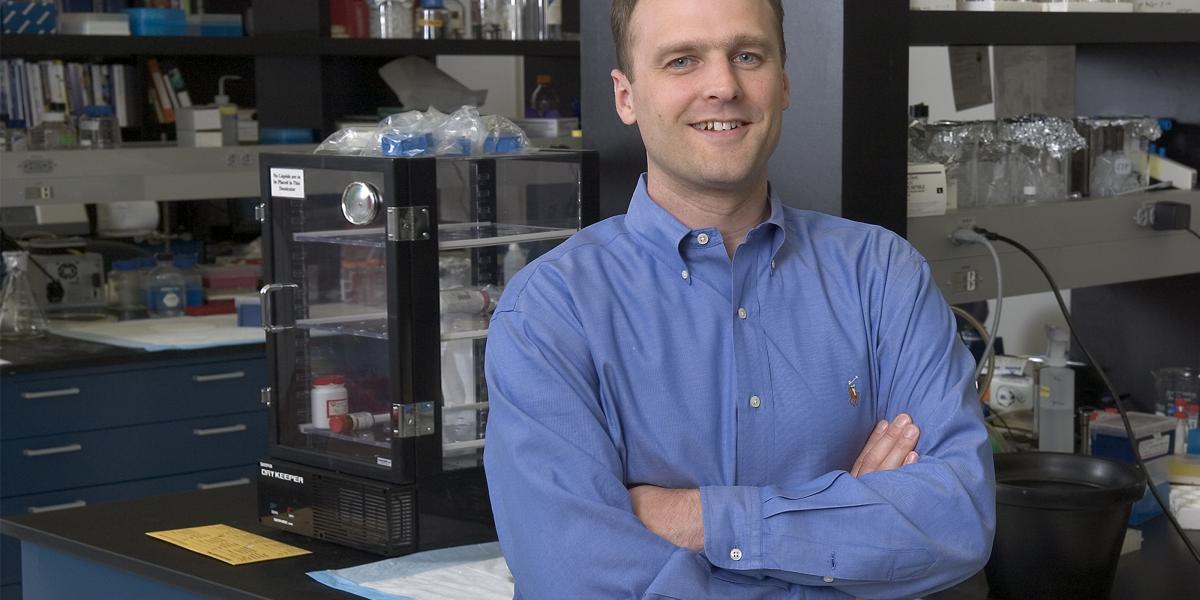Fighting Invaders
Creative thinking and futuristic science confront some of humanity’s most lethal enemies.
Beating Malaria with a Cocktail
In a way, malaria has been cured many times. In laboratories around the world, over and over again, scientists have found drugs that inhibit the malaria parasite, Plasmodium.
So why hasn’t the ancient disease that kills 1.5 to 3 million people a year been wiped off the planet? Because the malaria parasite develops resistance to drugs.
To eradicate malaria, “you have to pump out new drugs every year, or find several drugs that simultaneously hit more than one target,” says Sean Prigge, PhD, assistant professor of Molecular Microbiology and Immunology. “That’s why HIV cocktails have been successful—because they hit more than one target.”
Much of Prigge’s work on malaria could be considered target practice.
The targets are enzymes—proteins that cause a chemical reaction. Prigge is trying to block the function of the enzymes essential to the malaria parasite’s ability to grow. He is focusing on about a dozen enzymes involved in the creation of fatty acids. If he can hit any part of the fatty acid pathway, he can stop parasite growth.
One way to find inhibiting compounds is to look at those that work on bacteria with certain similarities to Plasmodium, such as E. coli. Some compounds that inhibit the enzymes in E. coli will work in Plasmodium.
When Prigge finds an inhibitor that works, he uses x-ray crystallography to look at the way it binds to the targeted enzymes in the malaria parasite, creating a map of the atomic structure of the molecules. These maps can be used by chemists to modify the inhibitor, because a compound that works in the Petri dish may not be safe for humans. “Mostly, it tells chemists what not to change,” says Prigge. “It could say, ‘Don’t touch that one part of the inhibitor, because it’s bound snugly to the protein.’ ”
A molecule called ENR is the first of the targeted malaria enzymes that Prigge’s lab has x-rayed with an inhibitor bound to it. His lab is also working with the Walter Reed Army Institute of Research to find an inhibitor for another target, KASIII. Prigge can envision an eventual cocktail of ENR and KASIII inhibitors.
“The best thing that could happen is that we could use structure-based drug design to create antimalarials—these [drugs] could then be co-developed with pharmaceutical partners,” he says.
Starve a Parasite, Feed a Cure
Isabelle Coppens is out to starve to death two nasty intracellular parasites—Toxoplasma, which causes severe neurological problems in newborns and immunocompromised individuals, and Plasmodium, the malaria parasite.
Neither organism can survive in the human body unless it can get inside a host cell and scavenge the nutrients they need for rapid growth. In order to kill off the two scourges, Coppens, PhD, an assistant professor of Molecular Microbiology and Immunology, and her team first delineated their nutritional needs.
Now, because both parasites need cholesterol to multiply but neither can synthesize this lipid, the researchers are trying to identify the particular protein molecule that ferries cholesterol into the organisms. The scientists are currently knocking out, one by one, every gene of Toxoplasma, to find all those whose removal stops cholesterol from flowing into the parasite. From the resulting pool of candidate genes, they will be able to trace (and then disrupt) the particular cholesterol-carrying protein they seek. (Checking out one gene takes three months’ work in the lab; the whole task could take at least two years.)
In addition to taking on Toxoplasma and malaria, Coppens’ work may provide new insights into one of the most common diseases in the industrialized world: atherosclerosis, the buildup of fat and other deposits on artery walls.
Toxic Needling
Once upon a time, microbiologists looked at disease very specifically. They studied a certain bacterium that attacked a certain organ to cause a certain illness. Different bacteria were… well, different. Or so the thinking went.
Then, 10 years ago, scientists discovered that disease-causing bacteria had specific mechanisms for injecting toxic proteins—and that these mechanisms were often the same for different bacteria.
“This was astonishing because not many machineries were known in bacteria,” says Egbert Hoiczyk, PhD, assistant professor of Molecular Microbiology and Immunology.
Hoiczyk’s laboratory is now looking at a needle-like mechanism in three species ofYersinia bacteria that cause bubonic plague and enterocolitis. This mechanism is shared by almost all disease-causing bacteria.
When a bacterium enters the body, cells go to work to kill it. Gooey, slow-moving things called macrophages engulf the bacterium. Enzymes then break it down, presenting the molecules on the surface of the macrophages. Immune cells read this information and kill the bacterium and others that look like it. “This is the immune system’s monitoring and surveillance system,” says Hoiczyk. “But
Yersinia has its own bag of tricks.”
When the Yersinia bacterium enters the human body, say, via contaminated food, it experiences an increase in temperature from the environmental level to normal body temperature, 37 degrees Celsius. At that temperature, the bacterium forms a hollow needle-like apparatus. This needle harpoons the cell membrane, and toxic proteins flow through that kill the macrophages. “It’s like when Captain Ahab took a ride on Moby Dick,” says Hoiczyk. These toxic proteins can then enter the cell unchecked, causing disease.
Hoiczyk wants to find out what causes Yersinia to make needles and proteins because many bacteria use the same needle machinery to cause a wide range of diseases: diarrhea, Chlamydia, typhoid fever and respiratory diseases. He also wants to discern the function of each protein in the needle apparatus and learn what protein causes what disease.
By answering these questions, Hoiczyk could encourage pharmaceutical companies to develop drugs to stop bacteria from making needles. A single drug could potentially be used to treat many diseases. “If we can shut one machine down, we can shut them all down,” he says.
